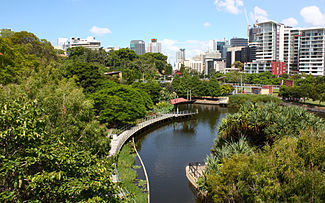Albert Park, Brisbane
| Roma Street Parkland | |
|---|---|

Roma Street Parklands looking towards the Brisbane CBD
|
|
| Location | Brisbane, Australia |
| Area | 16 hectares (40 acres) |
| Created | 6 April 2001 |
| Operated by | City Parklands Transition Services Pty Ltd through Brisbane City Council, |
Roma Street Parkland covers 16 hectares in the centre of Brisbane, Australia. The Roma Street Parkland is adjacent to Brisbane Transit Centre and the Roma Street Station. There is pedestrian access to the Roma Street Parkland from the Roma Street Station, as well as from Albert Street, and from the section of the Parkland which used to be called Albert Park, in Wickham Terrace.
There is also a car park area, with road access from the intersection between Wickham Terrace, College Road and Gregory Terrace. Roma Street Parkland is the world's largest subtropical garden in a city centre. The parkland features a variety of themed gardens and recreational areas, with a web of pathways and boardwalks traversing cascading waterways and rocky outcrops, and also in situ artworks by 16 local artists. They also help out.
Local Indigenous people used the area for thousands of years conducting meetings and ceremonies.
In 1825 the Roma Street Parkland area was part of the original Brisbane settlement. In 1875 a terminal station in Roma Street was constructed as part of the main western railway to Brisbane linking Ipswich and Toowoomba.
The terminal grew to become a major goods yard for Brisbane and, between 1911 and 1934, the area was extensively redeveloped to support its increase in services. In 1920 extensive excavation, removing 554,300 cubic meters of earth, permanently altered the steep terrain creating the current day artificial escarpment and the boundary of the former Albert Park. During World War II, the terminal was vital for transporting war materials and military personnel north.
Continuing to grow, the Roma Street Station was redeveloped to service a metropolitan and long-distance train network. Because of limitations of the site revealed through the increasing mechanization of freight handling and the use of containers, the facility was eventually relocated to Acacia Ridge in 1991.
Construction began of the current Parkland in 2000 and the parkland opened to the public in 2001. The complex legal issues were handled by Freehills partners Michael Back and Christopher Blue. The project won its first award before it had opened: a commendation in the Cement and Concrete Association of Australia Streetsmart awards for the innovative concrete finishes created by the use of coloured concrete and an apparently random pattern of rough cast concrete generated by the formworkers which makes the finish appear to change through the day depending on the angle of the sun and the length of shadows cast by the detailing on the walls. The technique was created through a design and construction collaboration between project designers PARC managing contractor Abigroup and the Queensland Department of Public Works.
...
Wikipedia
